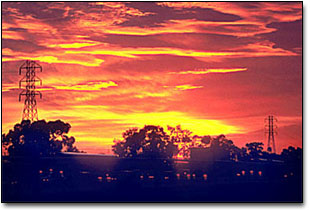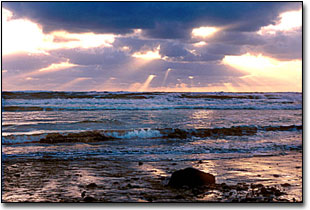|
|
 Photographic Meditation: Inner Vision Becoming Outer Reality
Text and photography Copyright Jon Lewis Were you aware that the way you see the world is a direct reflection of your thinking? As Wayne Dyer says, “Believe it and then you’ll see it.” I open with this quote because it directly relates to the link between our inner and outer vision and draws an interesting parallel between photography and life experience. Weaved together by the threads of thought, the creative tools learned for one are easily adapted to the other. This is not just glass half empty or half full stuff, this is about understanding the mind’s ability to envision what you want, then see and experience that in the world. This tool has obvious benefits for the photographer wanting to create fine images, as well, as non-photographers wanting to see and experience more beauty, balance and simplicity in everyday life. How do we do this and what are the implications for photography and for life? Could building photography skills actually enhance your life experience?
These qualities, such as nurturing beauty, balance and simplicity, are the cultivated assets in one’s life that become our mental, physical, emotional, and spiritual antidotes to life’s obligatory tension and drama. They’re what money can’t buy because we search the world over looking for beauty, but we must look for it within for it to be found. This is what adds real value and makes the greatest difference. These same assets are what makes a great photograph stand out. Applying this awareness to one is a definite way to affect the other. Expressing these qualities in a photograph is a pathway to the creation of them in your life experience and vice versa. Thus, the correlation between life and photography becomes clear. Choosing to become more aware of these qualities making a great photograph will automatically place you on the path to experience more of these qualities in your life. Believe it and you’ll see it. Why? Because our beliefs affect our thinking and our thinking affects our seeing. Therefore, a photograph is a direct result of this cycle, the product of one person’s focus on a tiny selection of what’s important to him or her in a moment of time to the exclusion of all else. This is photographic meditation. This is powerful. How you perceive the world shows up first in the pictures inside your head and then in the pictures you see in the world. To state it simply, how you see the world around you is a product of your thinking. Your thinking is a product of your beliefs. Your beliefs are the products of your life experience. Your life experience is a product of the events that happen, decisions you make and stories you then tell yourself. From this thinking, follows your actions and outcomes. The thing is we’re unaware of most of this stuff. Our beliefs usually run our thinking from behind the scenes in our subconscious. This is the reason why, despite your wishes to the contrary, life sometimes seems to create things you don’t want. But since there’s a direct link between what you choose to focus on and your thinking, you can affect a change on your beliefs by adopting new practices, such as choosing to notice how the qualities of beauty balance and simplicity show up around you.
Pay attention to what you are choosing to focus on because whatever it is, whatever you’re not “deleting”, will automatically increase in your life. Or in other words you will experience more of what you think about. Most of us are already familiar with this, if you’ve ever one day fallen in love with a certain automobile and then suddenly noticed that same car seems to be everywhere. This same principle can be applied to photography, by falling in love with perceiving the underlying beauty, balance and simplicity in life. As Van Gogh says, “If one really loves nature, one can find beauty everywhere.” In the real world, by choosing to see this way, I’ve experienced fantastic beauty, even at the most unforeseen times. The photo below I call “The Morning Commute”. Traveling down the 101 freeway in San Carlos, CA, with a thousand other commuters, I felt like I was in another world (see Photo 1). The dawn heralded such a dramatic sunrise, I could hardly believe what I was seeing. Heaven’s beauty unfurling and yet, looking around, it seemed as if I was the ONLY person noticing it. With my equipment in the car, I quickly pulled off the freeway racing along the frontage road searching for an unobstructed view. Next to a row of commercial buildings I stood on top of my car to clear the wire fence between me and the splendor unfolding before my eyes. This image is what I saw. This is my interpretation of that day. I can remember the syrupy slow traffic and long commute, but I wasn’t LIVING in that part of my experience. I choose to live in the beauty, balance and simplicity between the less appealing parts of my day, that’s what stands out for me, that’s what I experience and create. And so can you. Photo 2, a sunrise through the billowing steam of an industrial plant in Redwood City, CA, is a similar example of what world can be experienced through the power of an intention. Driving by this industrial site next to the freeway, I had been intrigued by the huge towers of steam rising skyward in the mornings. On successive mornings I would leave the house pre-dawn to embark on the adventure of experiencing moments when the beauty of nature transforms the ordinary into extraordinary. A field adjacent to the plant offered an ideal viewpoint to capture this moment when the sun, transformers, steam and fog combined to create a balanced moment of beautiful color and simple shapes from an otherwise uninspiring vista.
Does it matter if what we choose to focus on now will be as important to us later? No! Like a photograph what’s important in one moment may not be in the next. If your focus becomes a life long passion, great. If not, great. Don’t get stuck overanalyzing. Simply notice what’s important right here, right now and act upon that realization. Any experience you act upon whether successful or not is a gathered opportunity, a way to learn and grow. As Stephen Covey says, ”The main thing is to keep the main thing the main thing”. Are you ready to see it? Are you anticipating it happening? Are you prepared for when it does happen and ready to quickly act upon that opportunity? What world are you living in? What world are you seeing? Use your skills for creating great images to create a great life where you’re seeing and experiencing more of what’s most important to you, the things that make life great. Practice the transferable tools of photographic meditation to get underneath your thinking and program your beliefs to have more memorable moments of great beauty, balance and simplicity both in your photographs and your life. As photographers, our job is to see and translate our vision for others. By understanding how we’re seeing the world, we have a fantastic tool to assist us with creative vision, a tool that can transform lives. Using this tool is a big key to experiencing the world the way we want it to be. Whether you’re crafting a fine image, brainstorming a new business, breaking through a family breakdown or seeing new and better ways to run the office, the creative vision of photographic meditation is at the heart and start of winning solutions. Editor's Note - Jon Lewis uses nature and photography as a unique pathway to explore personal insight. Living in Leucadia near San Diego, he is the founder of Life Tools Photography and Coaching inspired by nature offering inspirational photographic art, workshops, outdoor learning adventures and group or one on one coaching. To contact or learn more about Jon and Life Tools Photography, visit his website at www.lifetools.org. JL - NPN 387 Comments on NPN nature photography articles? Send them to the editor. |
|
|
 Photo 1
Photo 1
 Photo 2
Photo 2
 Photo 3
Photo 3